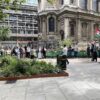Staff Writer Anoushka Sinha tracks the influence of the ancient art of origami on modern science and everyday life.
Marston Morse, the inventor of the famous Morse Code, once said: “Mathematics is sister, as well as the servant, of the arts.” Although the mathematician is unfortunately long gone, this theory, along with multiple other findings of his, continues to ring true today.
A critical area where we see this today is that of aerospace engineering. Various telescopes are launched into space and deployed using the ancient art of origami.
Although origami is a Japanese word, the art only migrated there from China about two thousand years ago. It was an art used specifically by monks who could afford paper for ceremonial purposes.
Today, however, the art of origami can be seen worldwide – from children’s classrooms to NASA and the European Space Agency.
The most recent telescope to be launched into space was the James Webb telescope. Located a million miles away from Earth, it orbits the Sun while using a primary mirror 6.6 metres across to collect light in the red and infrared wavelengths. This light is then concentrated using a smaller secondary mirror onto a small space where the image formed by the light source can be interpreted by scientists usually based in NASA. To be able to observe the faint lights far away, the telescope needs to block out the Sun’s overwhelmingly bright light; this is done using a sunshield which is over 20 metres across!
How on Earth (or in space) would this be packed and launched a million miles away, before being unpacked and assembled without damaging the system? The answer is, of course, origami.
Aerospace engineers and their accomplices make themselves experts in paper folding, testing out multiple methods before finding the most suitable one for their missions. The International Space Station uses a zig-zag formation to deploy its solar wings while Mars Rovers have been known to use circular fan-like designs for the same purpose.

It seems like maths is incredibly indebted to the arts when it comes to helping humans decipher the Universe. From using colour to represent the wavelengths of invisible light to using origami to fold the airbag in your car and keep you safe, the arts and the sciences merge together every day.
Perhaps it is time that so-called left-brained people and right-brained people stop considering the other their polar opposite. After all, it takes the work of both an artist like Van Gogh and a scientist like Galileo to appreciate ‘The Starry Night’ skies. And perhaps a little origami is what we need to dive deeper into space in the twenty-first century.










